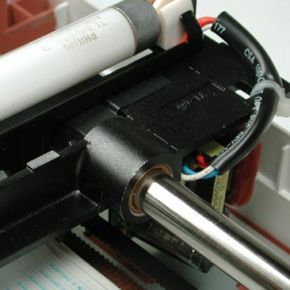The Scanning Process
Here are the steps that a scanner goes through when it scans a document:
- The document is placed on the glass plate and the cover is closed. The inside of the cover in most scanners is flat white, although a few are black. The cover provides a uniform background that the scanner software can use as a reference point for determining the size of the document being scanned. Most flatbed scanners allow the cover to be removed for scanning a bulky object, such as a page in a thick book.
- A lamp is used to illuminate the document. The lamp in newer scanners is either a cold cathode fluorescent lamp (CCFL) or a xenon lamp, while older scanners may have a standard fluorescent lamp.
- The entire mechanism (mirrors, lens, filter and CCD array) make up the scan head. The scan head is moved slowly across the document by a belt that is attached to a stepper motor. The scan head is attached to a stabilizer bar to ensure that there is no wobble or deviation in the pass. Pass means that the scan head has completed a single complete scan of the document.
- The image of the document is reflected by an angled mirror to another mirror. In some scanners, there are only two mirrors while others use a three mirror approach. Each mirror is slightly curved to focus the image it reflects onto a smaller surface.
- The last mirror reflects the image onto a lens. The lens focuses the image through a filter on the CCD array.
The filter and lens arrangement vary based on the scanner. Some scanners use a three pass scanning method. Each pass uses a different color filter (red, green or blue) between the lens and CCD array. After the three passes are completed, the scanner software assembles the three filtered images into a single full-color image.
Advertisement
The Scanning Process
Most scanners today use the single pass method. The lens splits the image into three smaller versions of the original. Each smaller version passes through a color filter (either red, green or blue) onto a discrete section of the CCD array. The scanner combines the data from the three parts of the CCD array into a single full-color image.
Another imaging array technology that has become popular in inexpensive flatbed scanners is contact image sensor (CIS). CIS replaces the CCD array, mirrors, filters, lamp and lens with rows of red, green and blue light emitting diodes (LEDs). The image sensor mechanism, consisting of 300 to 600 sensors spanning the width of the scan area, is placed very close to the glass plate that the document rests upon. When the image is scanned, the LEDs combine to provide white light. The illuminated image is then captured by the row of sensors. CIS scanners are cheaper, lighter and thinner, but do not provide the same level of quality and resolution found in most CCD scanners.
We will take a look at what happens between the computer and scanner, but first let's talk about resolution.
